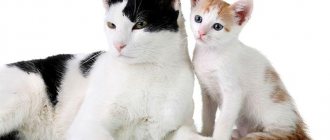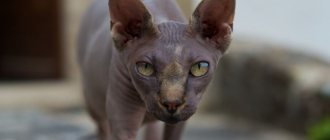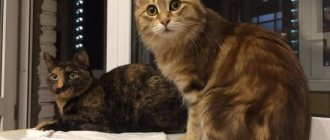Life cycle of mustachioed pets
The entire life cycle can be divided into 6 stages. Please note that they are all very conditional. Many cats remain playful and active even in their old age.
Infancy (up to 1 month)
Until 1 month, the kitten is completely dependent on the mother. In the first days after birth, he is blind and toothless, so communication with the outside world is very limited.
Childhood (up to 7-8 months)
With the appearance of the first baby teeth, the kitten begins to show more independence. He tries his first complementary foods and is actively learning new things.
At 2.5-4 months, the baby finally leaves his mother and learns to live independently. His molars gradually grow and puberty begins. By 7-8 months, female cats are already in their first heat, but they are still babies until their third heat.
Youth (up to 2 years)
At 1-1.5 years old males and female cats reach their first mating. They give birth to and raise their first offspring.
Youth (up to 4-5 years)
At this stage, breeders are actively breeding the breed. By age 5, most animals are removed for health reasons.
Maturity (up to 8 years)
The first behavioral changes appear. The cat becomes calmer and more reserved. She goes on crazy runs around the house less often, but still doesn't give up on games.
Old age (8-9 years and older)
At the final stage, there is a gradual attenuation of activity, an increase in sleep duration and the appearance of dental problems. The general well-being of the animal depends on the state of health.
In the absence of chronic diseases, significant changes are not observed. An elderly pet can be picky about food and show its devotion to its owner more clearly through affection and increased attention.
Bombay cat: history of origin
The history of the Bombay breed began in the mid-20th century, when an American cat breeder decided to breed a pet that looked like a mini puma. The breeder spent about 20 years to achieve her goals. At the same time, short-haired cats and Burmese cats took part in breeding.
At first, the newly bred breed of cats was not recognized in society and special organizations. For the first time, Bombay took part in an international exhibition in 1985, where they took second place.
What determines the lifespan of cats?
The lifespan of cats depends on a number of external and internal factors. Some contribute to its increase, while others contribute to its reduction.
What promotes longevity
Anything that has a beneficial effect on health is responsible for longevity. These include:
- balanced diet;
- timely vaccination, deworming and treatment against external parasites;
- absence of hormonal surges;
- safe maintenance to prevent injury;
- Regular visits to the veterinarian for preventive purposes.
All of the above are completely inaccessible to street cats. For this reason, they always die earlier than domestic ones.
What shortens years of life
Factors that reduce immunity and undermine health have the opposite effect. These include:
- living in unfavorable conditions (frequent temperature changes, dampness, unsanitary conditions);
- lack of regular nutrition, consumption of low-quality foods and lack of vitamins;
- genetic predisposition to certain pathologies;
- frequent pregnancies and childbirths;
- infection;
- free range, fraught with injury or death under the wheels of vehicles;
- frequent and prolonged stress;
- excess weight, which provokes problems with the musculoskeletal system and hormonal disorders.
All of the above can significantly reduce the allotted years by more than 2 times.
Description of Bombay cats: breed characteristics and standards
Popularly, Bombay cats are often called mini-panthers. All this is thanks to their black color and predatory grace. The wisdom of generations can be read in the eyes of these animals. The standard characteristics of the Bombay cat breed are the following characteristics.
Dimensions and weight
The Bombay cat has a muscular body. Their dimensions at the withers range from 25 to 30 cm, and the average weight of pets varies from 3 to 6 kg.
What does it look like
The Bombay cat is very beautiful. The standard characteristics of the breed are:
- round head and slightly elongated wide muzzle. Thanks to the nose rounded towards the bottom, cats have a beautiful profile, devoid of arrogance;
- average ear size. They are set wide and characterized by a slight forward tilt. The ears are slightly rounded at the ends;
- round, large honey-colored eyes;
- medium sized body. The body of the Bombay is slightly elongated and with well-developed muscles;
- slender and medium-sized paws. They have 5 toes on their front paws, and 4 on their hind paws. Other standards for the number of toes are not allowed;
- a straight and strong tail, which must be strictly proportional to the body.
Coat and color
Bombay cats have short fur that lies close to the body. Its color is exclusively black. Although some kittens are born with small brown spots that disappear as they grow older. When choosing a purebred pet, special attention is paid to the pads of its fingers. They must be black. The nose of these pets is also black. That is, the Bombay breed is characterized by a completely black color, with the exception of amber eyes.
Attention: Bombay cats attract people with their shiny and silky fur of a rich black color.
Possible breed defects
As for possible breed defects, these include:
- a curved or irregularly proportioned tail;
- unacceptable number of toes;
- irregularly shaped skull.
How many years do street cats live?
Approximately 85% of animals born on the streets die as kittens. This occurs due to weakened immunity, low temperatures, infections, parasites and poisoning. Stronger individuals usually live up to 4-8 years.
The worst situation is for domestic cats that are lost or abandoned by their owners. Being unadapted to such harsh conditions, they die from stress, cold and hunger within the first 3 years.
Life of a street and indoor cat
Life expectancy is affected by habitat. Well-groomed and caressed domestic cats live much longer than their street counterparts. The latter have to survive, get food, and hide from the cold in winter. In the cold, death from hypothermia overtakes animals quite quickly.
Kittens born in the basement or on the street die in the first months of life in 90% of cases. The reason for this is weakened immunity, lack of heat and viral diseases. Only the strongest survive, but they have yet to prove their strength in street fights. It is not surprising that they have a short life span - few live up to 7 years, and a 10-year-old street cat will be considered a long-liver.
Animals that end up outside from home find themselves in even worse conditions. Most often, the owners refuse them, indifferently throwing them away like an unnecessary rag. The chances of living at least a year on the street for cats unadapted to such conditions are negligible.
The life of a pet is a different matter. There is good food in the bowl, a warm bed in the room. Vitamins and vaccinations protect against diseases; at the slightest deviation, a caring owner will take all measures to restore the pet’s health.
Life expectancy of cat breeds at home
Longevity directly depends on the breed. Most artificially bred breeds are characterized by hereditary diseases that reduce the number of years allotted. This explains why the average age of mongrel cats that have escaped human intervention is often 5 years older.
Average and maximum indicators: table
The average and maximum age indicators characteristic of purebred animals can be found in the example table. It presents the 10 most popular representatives of the cat family.
| Breed name | Lifespan | |
| Average | Maximum | |
| Siamese | 15 | 20 |
| Scottish | 15 | 20 |
| Russian blue | 14 | 19 |
| Bengal | 13 | 16 |
| Maine Coon | 12,5 | 16,5 |
| Persian | 10-17 | 20 |
| British | 12 | 16 |
| Siberian | 15 | 20 |
| Abyssinian | 12-15 | 20 |
| Sphinx | 13 | 14 |
Most of these breeds do not live to their maximum age due to chronic renal failure, urolithiasis, polycystic kidney disease and cardiovascular pathologies.
Long-lived breeds
Long-livers include all representatives of the Siamese-Oriental group, Maine Coons, Siberians and other aboriginal breeds. All of them were able to avoid direct human intervention in their long history of development and went through the most reliable selection - natural selection. Thanks to him, Aboriginal cats received strong immunity and good health.
Maximum age of a cat
The Guinness record holder is the long-lived cat Cream Puff, who lived a little over 38 years. Among the living, the leader in life expectancy is the British mongrel pet Lucy, she is already 43 years old. Such indicators are typical for Western countries, where pets are sometimes treated even better and more attentively than family members.
Which cats live the longest?
Naturally, breeders try to choose a breed not only by appearance, but also by life expectancy. It is normal to want your beloved pet to stay close to you for as long as possible. The leaders in life expectancy are Siamese, Bengal, Persian, Siberian and Maine Coon cats. The minimum age in our country for sphinxes is due to the fact that the climate is absolutely unsuitable for the breed, and home maintenance is rarely maintained at the required level.
- How to improve erection
- 5 foods you shouldn't eat if you have a cold
- Is the retirement age different for social and insurance pensions?
How castration or sterilization affects longevity
Contrary to popular belief, surgery to deprive reproductive function does not shorten, but prolongs the life of your pet. This happens thanks to:
- softening of character (the cat stops getting into fights and looking for adventures);
- prevention of oncology and sexually transmitted diseases;
- absence of hormonal surges due to medications, pregnancy and childbirth.
Frequent birth and feeding of kittens greatly wears out the body. He suffers not only physically, but also emotionally. After sterilization, this problem completely disappears, as does the possibility of developing cancer. Thanks to the operation, the overall life expectancy is increased by 3 years.
The only disadvantage for castrated animals is their tendency to become obese. Due to a slower metabolism, they gain weight faster, so their diet must be strictly controlled.
Prime: 3- 6 years
As the name of this phase suggests, during these years the cat will be in her prime. While they are young and healthy, it is important to ensure that the pet is vaccinated and examined by a veterinarian on time.
Ways to help prolong the life of a pet
If your cat is approaching her final stage, don't despair. After all, for many, life after 8 years is just beginning. By following a number of recommendations, this period can be extended as long as possible.
Proper nutrition
Don't skimp on the quality of your products. Buy meat, vegetables and dairy products in trusted places or choose ready-made food of at least premium quality.
Be sure to follow the feeding schedule, avoiding overfeeding and handouts from the table. Remember that on a natural diet you must add vitamins prescribed by your veterinarian to your food.
Competent care
Avoid the formation of tangles and strong darkening of tooth enamel. Brush your pet 1-2 times a week and brush his teeth every month.
Also remember to keep your eyes and ears clean. Remove any secretions that accumulate in them and be sure to contact a veterinarian if an unpleasant odor or foreign matter appears.
Pay special attention to physical activity. Monitor your cat's weight and don't let him nap on the couch too often. Outdoor games improve health, promoting longevity.
Vaccinations and disease prevention
Most infections can be prevented through vaccination. The first vaccination followed by revaccination is given when the child reaches 2 months of age. With the onset of the year, the frequency of grafting reaches no more than 1 time per year.
In addition to viruses and bacteria, you should be wary of parasites and genetic pathologies. To prevent them, it is necessary to promptly treat with anthelmintic and acaricidal drugs and undergo an annual preventive examination at a veterinary clinic.
No stress
The family situation plays a big role. The absence of quarrels between owners and a reverent attitude towards the pet have a positive effect on mental health.
Sexual health
When participating in breeding, all rules must be strictly followed. Do not attempt to start your breeding career early or exceed the recommended birth rate. Bearing offspring is always accompanied by severe nervous tension and hormonal changes, so timely retirement is very important here. Otherwise, the animal risks not living to its allotted time.
If breeding and selling kittens is not part of your plans, sign up your pet for castration immediately after puberty. This will protect her from cancer and other dangerous complications associated with hormones. A similar choice should be made regarding the cat.
Requirements for the place of detention
Pets should be kept in a warm and clean environment. Locate the sleeping area away from drafts and prohibit your pet from sleeping on a tiled floor. To avoid hypothermia, be sure to accustom your cat to a bed or install an underground heating system.
Don't forget to change the litter in the tray, wash food bowls after each feeding and change the water daily. Remember that not only freshness is important, but also the absence of foreign impurities. Water must be purchased from a store or passed through a filter to remove any sediment it contains.
What can you do to prolong your cat's life?
Don’t despair if your pet is approaching the “average” age. Each owner can extend the life of his pet by following only a few rules:
- closely monitor the well-being of your furry friend and immediately contact a veterinarian at the slightest deviation in behavior;
- promote cat physical activity;
- do not allow self-walking;
- sterilize the animal;
- wisely select a diet containing proteins, vitamins, and minerals;
- take care and give affection to your pet, do not expose it to stress.
Approximately 30% of domestic cats suffer from chronic renal failure. It is impossible to completely cope with the disease, but if you notice it in time, you can maintain your pet’s health and significantly extend its life.
Cat to human age ratio
The most popular method of converting a cat's age to a human age is 1 to 7. Despite this, it is the most unreliable. Instead, they are increasingly using a scheme with a slow growth rate. In it, 1 year is equated to 15 years, 2 years to 9, and each subsequent year to 4. That is, a one-year-old cat is a 15-year-old teenager, the same animal at the age of 2 is a 24-year-old independent man, and at 3 and 4 years, the age of the mustache is equated to 28 and 32 years, respectively.
Veterinarians usually adhere to the scheme from the international veterinary passport. According to him, the ratio is as follows:
| Cat age (years) | Human age (years) |
| 1 | 18 |
| 2 | 25 |
| 3 | 30 |
| 4 | 35 |
| 5 | 40 |
| 6 | 43 |
| 7 | 45 |
| 8 | 50 |
| 9 | 55 |
| 10 | 60 |
| 11 | 62 |
| 12 | 65 |
| 13 | 68 |
| 14 | 72 |
| 15 | 74 |
| 16 | 76 |
| 17 | 78 |
| 18 | 80 |
| 19 | 90 |
| 20 | 100 |
But here everything is very conditional. Maine Coons and Siberians have a very long adolescence, so at 4-5 years their psychological age is close to adolescence.
Geriatric (15 years and older)
Some cats can make it to this age without any signs of slowing down (for some, this is luck). But most will live a slow life, happily snoozing all day on their favorite pillow.
Geriatric cats should be monitored more closely for changes in their behavior; this may include things like vocalizations and frequency of toileting. If you notice anything unusual, it is best to make an appointment with your veterinarian.
Determining the age of a kitten or adult cat
It is impossible to determine the exact age of an animal taken from the street, but an approximate age is not at all difficult. Veterinarians determine it by external signs: the condition of the teeth, fur, mustache, eyes and musculoskeletal system.
The older the cat, the more worn out his teeth are. Very old individuals may lack incisors and fangs. Also, with aging, dulling and thinning of the coat is noted. By the age of 10, the first gray hair appears, spreading from the fur coat even to the mustache. The animal's eyes become dull and the spine begins to sag. The gait loses its former confidence, and the claws lose flexibility.
How to survive the death of a cat
Losing a pet at any age is a difficult loss. But sooner or later this happens to all animals. When the time comes to say goodbye to your cat, life can suddenly feel very empty.
Don't blame yourself, but don't hold back your feelings if you want to be sad and cry. This is a normal psychological reaction to the loss of a full family member, friend, companion.
Put away all the things of the deceased animal, the remaining food, litter for the tray, or better yet, take them to the shelter. Take a closer look at the shelter's inhabitants. Perhaps you can give your love to another animal
If your heart is not yet ready to open to another cat, donate as much as you can to a charity or animal shelter.
Read how to find and adopt a kitten at a shelter.
Centenarians
Did you think that 2 tens is the life limit of a cat? But no: the absolute record holder since 2010 is Lucy from the UK. The owner does not know the exact date of birth, but it is known that she is about 40 years old - veterinarians confirm her age. Only deafness speaks of old age, but the pet’s activity is still at its best.
In 2015, outbred Jessica was recognized as the oldest cat in the Belarusian city of Slutsk. To date, there is no information about her life.
An amazing incident happened with the cat Prokhor from Russia. At the time of recording the record, he was 28 years old, but this is not the most interesting thing. At the age of 23, the centenarian... new teeth erupted!
In the Guinness Book of Records you can find other pets who managed to live a long and happy life. In 2010, she received the outbred Cream Puff, who was 38 years old at the time of death. Soon the book was supplemented by the Canadian Sphynx named Granpa Rex Allen - his journey lasted 34 years and 2 months. A cat of the Sacred Burmese breed from Australia is confidently setting a record - she is 37 years old.
In one of the remote villages of Great Britain, the cat Spike, whose life span exceeded 30 years. Thus, we can safely say that I was able to use 9 lives. When he got into a fight with a dog at 19 and was injured, veterinarians spoke of imminent death. After this incident, Spike spent another 11 years happily.
With love, care and the right type of SUPERPET nutrition, your cat will live long and happy years.
No one knows how many years your four-legged friend will live. Average life expectancy depends on many factors. Try to fill your short life with love and care, choose the right food and monitor your pet’s health. By giving away your warmth, you get it back several times more.
Bombay Breed Health
The Bombay cat is in good health. With proper care, proper maintenance and a balanced diet, they almost never get sick and live a long time.
How long do cats live?
With proper care and maintenance, Bombay cats live from 15 to 20 years.
What do they get sick with?
Since the Bombay cat is an artificially bred animal, it is prone to the following genetic diseases:
- eye diseases. This breed produces a lot of tears, so it is necessary to purchase special eye washes from the vet for them. pharmacies;
- heart diseases. The main signs of the disease are fainting, shortness of breath, prolonged sleep, rapid breathing;
- skull defects;
- cystitis;
- gum diseases.
Caring for a Dying Cat
When an animal is unwell, it should be placed on a soft bedding or bed. Keep your cat's sleeping area tidy and wash its bedding once a day. If the cat cannot hold back its urine, then place disposable diapers on the bedding. If the cat is powerless and cannot go to the toilet on its own, then you need to carry the animal to the litter box every 3-4 hours. If the cat does not respond to affection and wants to be alone, then there is no need to disturb him.
To ensure that the animal’s body maintains an optimal temperature, you can cover your pet with a blanket and place the bed closer to the radiator. Try to measure your cat's body temperature every two hours. Make sure that neither other animals nor children bother your sick pet. After consulting with your veterinarian, give your cat painkillers. These can be morphine-based drugs (opioids) used for severe pain (Tramadol, Omnopon, etc.), and non-narcotic drugs used for moderate pain (Ketofen, Quadrison, etc.).
Important: if the cat does not eat, then there is no need to force it, occasionally offering food and drink.
How to tell if your cat is in pain
The following signs will indicate that your animal is in pain:
- immobilization;
- screams;
- finding a convenient place;
- unnatural poses;
- detachment, decreased sociability;
- dilated pupils;
- looking at one point, etc.
My cat Freckles is dying now, it’s a damn shame, because she lived in our family for less than 2 weeks for 18 years. A year ago, she began to lose weight, began to sleep more, and generally looked healthy. Literally 4 days ago I started vomiting, stopped eating anything at all, lay down, and didn’t go to the toilet. Now it’s lying next to the radiator, I’m petting it. The twitching has already begun, sometimes she tries to get up in agony, but she has no strength and she falls again. It’s hard to look at this, she is part of our family.. Only one thing calms me down - she lived a long happy life, so it seems to me, but time takes away loved ones... All the best!
Andrew
https://www.woman.ru/home/animal/thread/3948729/7/
On the last day before her death, our cat lay in bed. I sometimes came up and stroked her, which she did not resist. It seems to me that she didn’t care anymore, but I hoped that my affection and participation would help her.
How to extend the life of your pet: tips for owners
In order for the cat to please its owners and be healthy, it is necessary to follow simple recommendations from veterinarians:
- Provide balanced nutrition and access to fresh water. Wet and dry food should be given in portions, since exposure to air causes it to weather and deteriorate, which can lead to poisoning and intestinal problems.
- Regular examination at the veterinary clinic will allow timely diagnosis of the disease. Cats are good at hiding pain, so any changes in the animal’s behavior are a reason to consult a doctor. You should not refuse to vaccinate your pet, even if it does not go outside.
- Neutered animals lead a calm and safe life, so timely sterilization should be carried out.
- Physical activity and games are the key to health and long life, and the attention of the owner and communication with people make cats happy.
- You cannot neglect the basic rules of caring for your pet. Timely deworming, flea treatment and teeth cleaning will help improve your cat's quality of life.
Character of black Bombay cats
Bombay cats have a friendly character. Their peculiarity is their unique singing, reminiscent of real works. The voice of these animals is not similar to their relatives. Although most Bombays are silent, among them there are individuals who are talkative in nature, delighting their owners with long and unusual stories.
These cats love to climb onto their owner’s lap and, looking into their eyes, talk about their business. They love to be petted, scratched behind the ears and just spend as much free time as possible. They constantly expose their sides to their owners to get their share of tenderness. But this breed cannot stand loneliness. Therefore, if you are not able to devote enough free time to your pet, then you should not get a Bombay cat.
Attention : this breed loves all family members, but considers one person to be the owner.
Bombay cats are very loyal to their owners. They are always waiting for them home from work or school and are ready to adapt to any of their moods. This breed is obedient, attentive and careful. They greatly value the authority of their owners and will never anger them.
This breed gets along well with both adults and small children. They will never offend a child, even if he hurts them. In the worst case, the pet will be offended and hide in a secluded corner.
Cats also get along well with other pets, to whom they always show friendliness. However, if a new pet appeared in the house after the cat, he will have to adapt to the rules established by Bombay.
Attention: Bombay cats are looking for any excuse to climb into their owners' laps.
This breed does not like walking in the fresh air, and even more so, it is not adapted to street life. Once outside, pets begin to get nervous. The most comfortable environment for them is the walls of their home. Only here they feel comfortable and safe.
Factors influencing a pet's lifespan
At home, cats can live a long time if their owners show attention and care. Veterinarians advise paying attention to several important factors:
- Nutrition. With a balanced diet, the animal’s body receives all the necessary vitamins and nutrients. Proper nutrition allows cats to stay healthy longer and lead an active lifestyle. Your pet's weight should be monitored, as obesity causes many serious diseases, including diabetes.
- Stress. Cats that are in close contact with their owner live much longer. The cause of stress may be the indifference of the owner, regular punishment or lack of attention. Excessive fuss, constant quarrels in the house and loud noise can lead to cardiac arrest of the animal.
- Genetics and chronic diseases of cats. Bad heredity significantly shortens a pet’s life, which is why half-breeds are considered healthier. To highlight the main characteristics of the breed, breeders practice mating between close relatives, which increases the risk of transmitting genetic diseases. Chronic diseases are incompatible with longevity because they attack important systems in the animal's body.
Characteristic hereditary diseases are often associated with traits that are specifically bred for a particular breed. Distinctive characteristics based on gene mutations are found in Scottish Folds, Manxes, Persians (an extreme variant with a very flat muzzle), Burmese and Oriental Orientals.
- Acquired diseases. Not all cat diseases become immediately noticeable, so veterinarians advise regular examinations of your pet in the clinic. Obvious signs are characteristic of the acute stage of chronic diseases, when maintenance therapy is introduced as treatment.
- Cat care. Living conditions can affect a pet's lifespan. Physical injuries, accidental poisoning, the presence of parasites and lack of food negatively affect the cat's health, reducing its stay on the ground.
Care and maintenance
The Bombay black cat is completely unpretentious in care. The main thing is to properly structure their diet, devote more time to play and affection, and periodically carry out hygiene procedures. By nature, cats are very active. Since they spend almost all their time in the house, it is necessary to provide them with loads. An excellent choice would be to purchase a special labyrinth, build shelves, and cat houses. It is advisable that the owner also takes part in the pet’s games.
How to get a kitten
Having decided to get a small Bombay kitten, you need to take a responsible approach to choosing a cattery. It is advisable to read online reviews from previous buyers in advance and compare prices.
In which nurseries can you buy a kitten?
You should only buy kittens from proven and well-established nurseries. When purchasing, you should pay attention to the presence of vets. passports, which must indicate all vaccinations received.
What to look for when choosing
If you want to buy a purebred, strong and healthy Bombay kitten, you should not buy a pet from unverified breeders based on photos on the Internet. It is better to look at him live, and then only in a trusted nursery with an impeccable reputation. To make sure that this is a real Bombay, it is recommended to meet the kitten’s parents. Also, when choosing it, you should pay attention to:
- shiny and glossy coat;
- absence of inflammatory processes in the eyes;
- activity;
- grooming.
How to name
As for choosing a nickname for a newly acquired kitten, this is a personal matter for each owner. Most people, when purchasing a new pet, already come up with a name for it in advance, and some choose a nickname only after getting to know the animal’s temperament and habits. But the most common names for Bombay cats are: Carmen, Ada, Sheila, Becky, Kira, Darlene, Boomer, Sooty.
In conclusion, it is worth noting that with the purchase of a Bombay pet, a truly devoted, friendly and attentive friend will appear in your home. He will adapt to your mood, spend free evenings in your company, and simply give positive emotions and a good mood.











